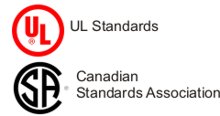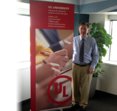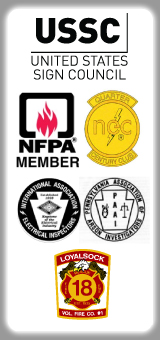NFPA 70 National Electric Code
The sign and lighting industries rely heavily on the safety provided by the National
Electric Code (NEC) provided by the National Fire Protection Association as NFPA 70
and updated on a three year cycle. The document is only a guide to be used by
electrical inspectors to approve equipment and it’s connection to the building power.
(Grid) The code only becomes law when adopted by a State, City, County or local
municipality. The document has it’s authority provided from the local building codes.
The code provides guidance for the electrical inspectors to insure safety by requiring
listed and labeled equipment and review how the product is connected to the grid.
The code also requires through OSHA that the UL standards comply with the current
version of the code.
NFPA 70E Standard for Electrical Safety in The Workplace
NFPA 70E was originally developed at OSHA’s request to address electrical hazards
in the workplace. OSHA bases its electrical safety requirements on the comprehensive
information in NFPA 70E. OSHA considers NFPA 70E to be an effective how-to manual
for OSHA regulation compliance. OSHA 1910.132 requires the use of personal
protective equipment when working around electrical hazards and requires the
employer to provide a component person to establish the risks and the equipment
required to work in this area. NFPA 70E has recommendations for the different hazard
categorizes. Lockout/Tagout procedures, safety programs, and risk assessment
programs, to name a few.
Labelling and Identification Methods
 |
(Primary Identification Shown)
Standards created in North America are developed by (CSA) Canadian Standards
Association and (UL) Underwriters Laboratories. These organizations work together to
created Bi-National Standards and the labels are marked to indicate where suitable
to be applied.
|

 |
(Variants)
The first label is United States only, the second in Canada only
and the last label is good in both countries. UL Listing means that UL tested representative samples of the product and determined
it meets UL’S requirements. These requirements are based primarily on Ul’s published
and notionally recognized Standards for Safety. (Reprinted from UL.com)
|

|
The UL Certification Mark now bundles multiple Certifications into a single
mark; utilizes a unique identifier for easier access to information at
www.ul.com/database; communicates geographic scope of certification
throughout country codes; and describes the attributes that UL has
Certified about the product. (Reprinted from UL.com)
|
 |
UL Classification means that UL has tested and evaluated samples of your product with
respect to certain properties of the product UL classifies products to. (Reprinted from UL.com)
Classified products will be shipped with their installation instructions, wiring methods and
how they fit into a complete system that will be listed or certified when complete. The
product must be accompanied with a statement indicating the specific scope of the
classification and control number. Some of the more common uses of this label is on
LED drivers and power supplies when the units can have multiple uses. They can be
used as part of a listed sign retrofit kit. The power supply can also be installed in the
factory as part of a listed electric sign.
|
 |
Recognized components are those products that have been evaluation as a component
to be used in a listed product. Components for the sign industry can be selected from the
new UL IQ which is an electronic version of our old SAM sign accessory manual.

These products are selected based on the use, wiring method, and their evaluation to
fit into the complete finished product that will be listed or certified.
Any NRTL Nationally Recognized Testing Laboratory MET, ETL, CSA to name a few can
test to the above standards and provide alternate certification based on their
compliance to the OSHA requirements. You can search the OSHA site for a specific
NRTL and the products that they can certify. |
| |
|
|









